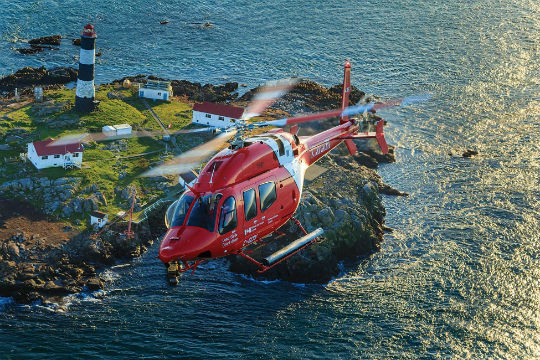
A Canadian Coast Guard (CCG) Bell 429 flies off the coast of British Columbia. The CCG now has 10 of the aircraft in its fleet.
At the recent Helicopter Association of Canada convention and trade show in Vancouver, B.C., there was one aircraft in particular that was catching the eye of intrigued attendees on the static display. The appearance of a Canadian Coast Guard (CCG) Bell 429 — resplendent in a brand new bright red livery — marked something of a public debut for the aircraft, one of 10 the service has now received.
The CCG ordered a total of 15 Bell 429s to replace its aging fleet of 13 MBB Bo.105s in May 2013, in a contract worth an estimated C$172 million. The composition of the rest of the CCG’s future fleet was revealed in March 2015, when it ordered seven Bell 412EPIs to fulfill its requirement for medium-lift aircraft, at a cost of up to $155 million.
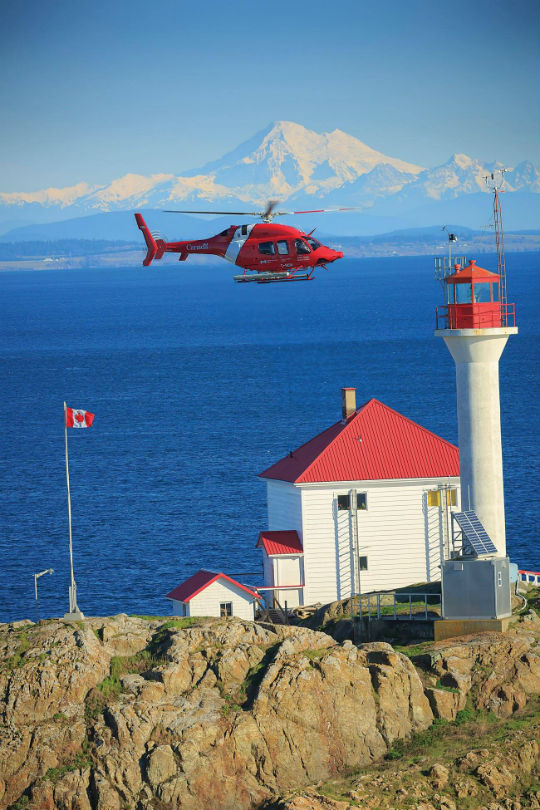
The Canadian Coast Guard operates over some spectacular scenery. In the foreground is the iconic Trial Islands lighthouse off the coast of Victoria, B.C., and in the distance is Mount Baker in the state of Washington.
The awarding of the light twin contract wasn’t without controversy, with other manufacturers accusing Transport Canada’s National Aircraft Certification Branch of giving Bell an unfair advantage when it granted the 429 a 500-pound (225-kilogram) maximum gross weight increase in December 2011 (from 7,000 to 7,500 pounds/3,175 to 3,400 kilograms), but now that the first 429s have entered operation, the focus is squarely on the jump in performance provided by the new generation of aircraft.
In replacing the Bo.105s, the 429s are essentially inheriting a wide-ranging mandate of logistical support — to programs such as aids to navigation, icebreaking services, marine communication traffic services, environmental response — and, to a limited extent, search-and-rescue.

The first CCG Bell 429 began operations in July 2015, and had already amassed 200 flight hours by mid-November.
“The mandate for the Coast Guard remains unchanged, so we’re now better able to satisfy that mandate with a more capable aircraft,” said Steve Buckles, director of flight operations at Transport Canada’s Aircraft Services Directorate (which supplies the pilots and maintenance crews for the CCG aircraft). “The aircraft is faster, it lifts more, [and] the internal volume is higher, so when we are performing those roles, we’re better able to do it.”
Buckles said the 429 was selected because it fully met the CCG’s operational requirement in all areas. Those requirements included the ability to carry a disposable load “of a certain weight” — and to be able to do that at a minimum of 120 knots for two hours and 20 minutes. “That was the big one; others were related to some of the technology — the autopilot, [and] the GPS systems on board,” said Buckles. “Blade folding also had to be such that the aircraft would fit in the existing [ship] hangars, because we had no authority to find any funding whatsoever to change the infrastructure that we operate these in. Many of the hangars had been constructed to house Bell 206s [the predecessor to the Bo.105 in the CCG fleet], so the aircraft had to fit in the same envelope.”

Bubble doors and vertical reference gauges were the only modifications made to the aircraft for the CCG.
Buckles said the only modification made to the basic 429 aircraft has been the addition of a bubble door and vertical reference gauges. “We do a lot of vertical reference slinging in construction-type operations, and with the bubble door on this aircraft, we are able to do that in a more efficient manner,” he said. “The 105 did not have a bubble door, so there were limitations in terms of outside air temperature and rain we had to respect, because the crews would not be able to handle it hanging out the door in all operating conditions.”
He added that in sling operations conducted with the 429, it has proven very stable, and crews have been able to lift “quite a bit more” than they could with the Bo.105.
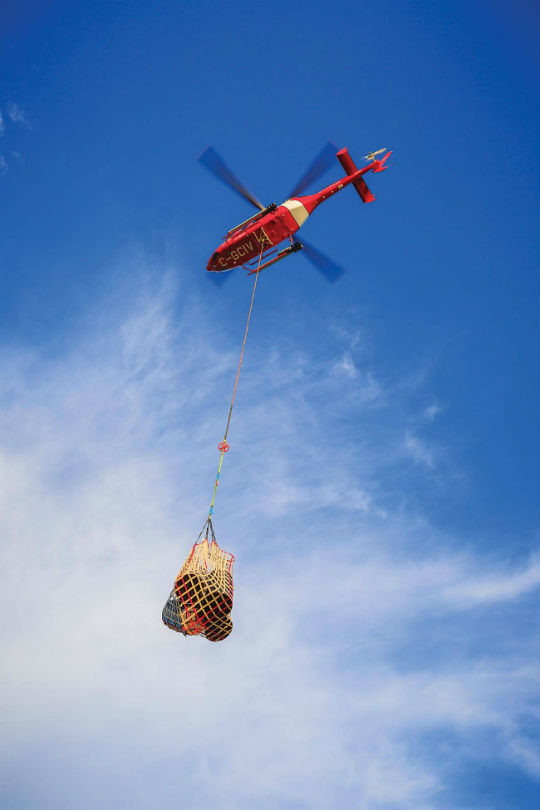
Sling operations with the 429 had shown the aircraft to be very stable, said Buckles — and the aircraft has been able to lift “quite a bit more” than its predecessor, the MBB Bo.105.
An accelerated delivery plan
Of the 10 429s the CCG has received to date, four are operational in Victoria, B.C., one has been sent to St. John’s N.L., and one to Quebec City, Que. The first began operations in July, with subsequent aircraft following at an initial rate of one per month, rising to two per month in September.
Over the next three months, the rest of the 429s will be sent to Eastern Canada. The plan is to eventually have one in Charlottetown, P.E.I.; one in Saint John, N.B.; one in Stephenville, N.L.; one in Parry Sound, Ont., and the remainder split between Shearwater, N.S., St. John’s, and Quebec City. “It’s quite an aggressive program; we’re introducing these 15 new aircraft essentially in nine or 10 months,” said Buckles.
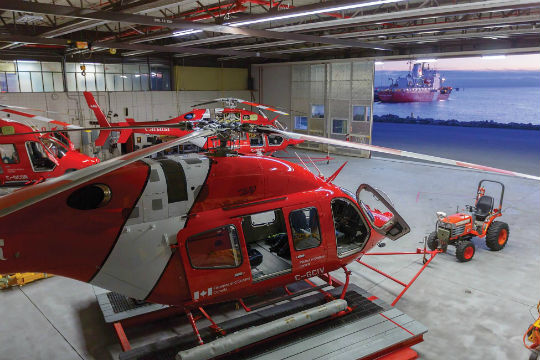
There are currently four Bell 429s at the Canadian Coast Guard facility in Victoria, B.C.
He said from the operational perspective on shore, the 429 has been “very well” received so far.
“The aircraft is living up to expectations, and we’ve seen a big improvement in our productivity. The offshore work has not really started yet, although the ships’ crews have been very interested.”
As of November, Buckles said the CCG had completed two sessions of deck trials. The first was in Quebec City in September, where the crews checked out the tie-down points for the aircraft, practiced blade folding, and moved it in and out of the hangar. Then, in early November, the CCG sent a team to Victoria to practice a trial at sea on the CCGS Sir Wilfrid Laurier.

The 429’s primary role will be in providing logistical support to programs such as aids to navigation, icebreaking services, marine communication traffic services, and environmental response.
“They were out there for two or three days and went through a number of different exercises, some vertical reference slinging, landing, taking off, blade folding, [and] moving it in and out of the hangar,” said Buckles. “We’ve had a couple of operational occasions to land on the ship in British Columbia, but we haven’t had any full-blown offshore operations as of yet.”
He said there have been no major problems in terms of moving the 429 around the deck or getting it into the hangar, but a couple of tie-down points may need to be moved.
Getting up to Speed
Of course, with the addition of a new type in the fleet, Transport Canada’s Aircraft Services Directorate has also had to manage the accompanying training for its pilots and maintenance crews. The pilots have been completing theirs at the Bell Helicopter Training Academy in Fort Worth, Texas, which is then followed by Aircraft Services’ own full initial course back in Canada.

Deck trials with the new aircraft began in September, and Buckles said no major issues have been discovered so far.
“We also have them flying for a minimum of 10 hours with another pilot on board just to get used to the instrumentation and have two sets of eyes in the cockpit so we are sure that one is looking outside at the same time as the other flies,” said Buckles. “We’ve been careful to try to make the transition as seamless as possible, recognizing that we are on a learning curve, so we’ve set certain operational limitations in place that will last for another few months while we get our minds fully around this new technology.”
The maintenance personnel have also been taking the manufacturer’s courses: one with the airframe in Fort Worth, and another for the engines in Montreal, Que. “The maintenance teams are finding it very interesting,” said Buckles. “We are looking at an aircraft that is generally run by downloading information from the various sensors and data collection systems on board. It’s quite a difference from the steam driven hydromechanical aircraft we’ve had previously, and so they’re seeing a need to transition to thinking a little bit differently about an aircraft in terms of some of the maintenance that’s needed. It’s a learning curve for them as much as it is for the pilots.”
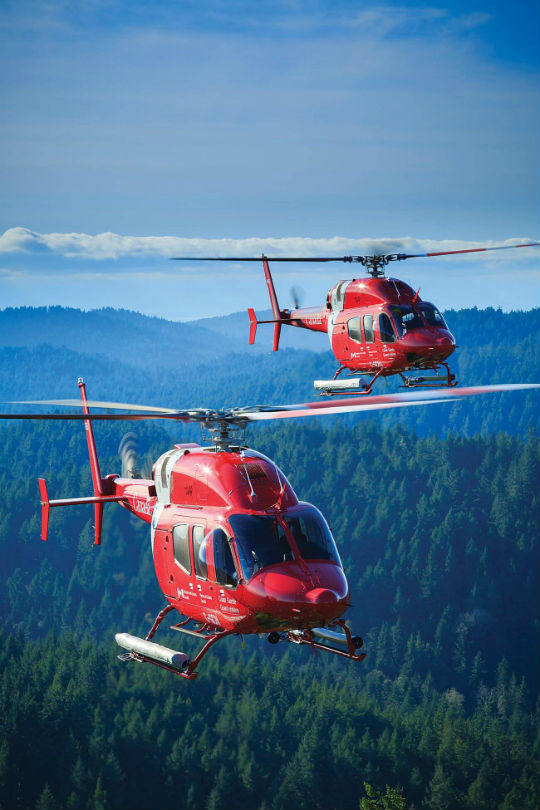
The Canadian Coast Guard’s fleet of Bell 429s will eventually rise to 15 aircraft.
The new aircraft are quickly amassing hours — as of mid-November, the first CCG 429 had already recorded 200 flight hours, with the other airframes catching up fast.
As for the Bo.105s, they are transitioning out as the new aircraft enter operation. One has already been sold, another is up for sale, and the remainder will be put on the market within the next several months. Buckles admitted that after 25 years of service, it would be sad for the CCG crews to see the old aircraft go.
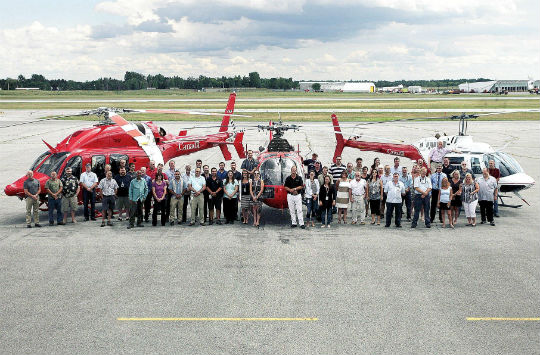
Three generations of Canadian Coast Guard helicopters: the Bell 429, the MBB Bo.105, and the Bell 206. Tom Littlemore Photo
“The 105 has served us well and did a fine job in replacing the Bell 206Bs for many years” he said. “The 429 gives us the ability to embrace the new technology and enhance our capacity and effectiveness in providing service to the Coast Guard and this is thought of very highly by the crews.”
Looking ahead, Buckles said there were “a couple of fine tuning elements” that need to be agreed upon with Bell before a firm delivery schedule is finalized for the 412EPIs, but he looked forward to continuing a long-established relationship with the manufacturer. “We’ve been operating Bell 212s and 206s for many years,” he said. “This is a continuation of that sort of relationship, and they’ve always provided us with top-notch service, and we expect it to continue.”
Overall, Buckles said he was extremely pleased with how the procurement process had gone. “I’ve seen a few projects over time, and all in all, this one has gone very, very, well.”









